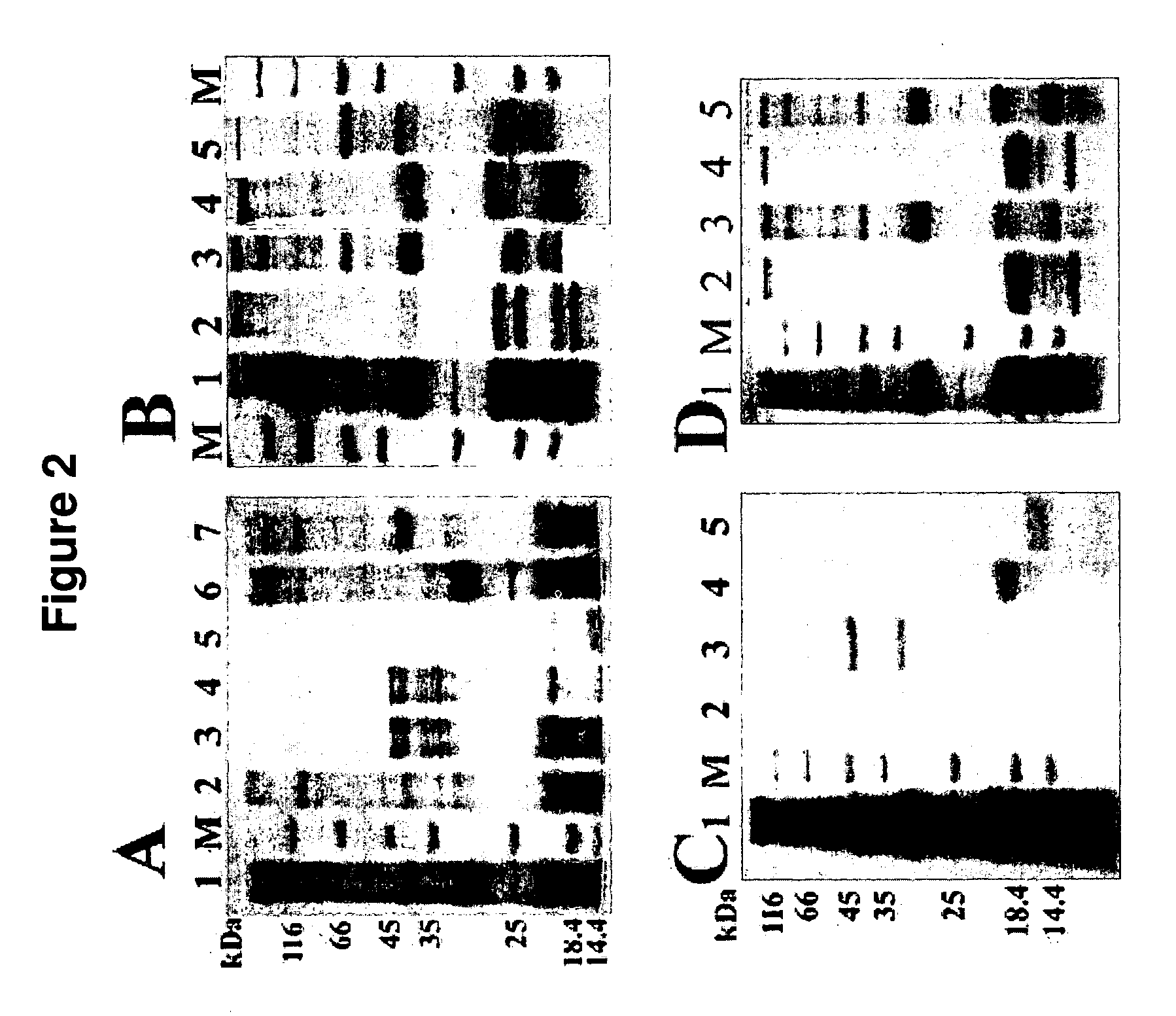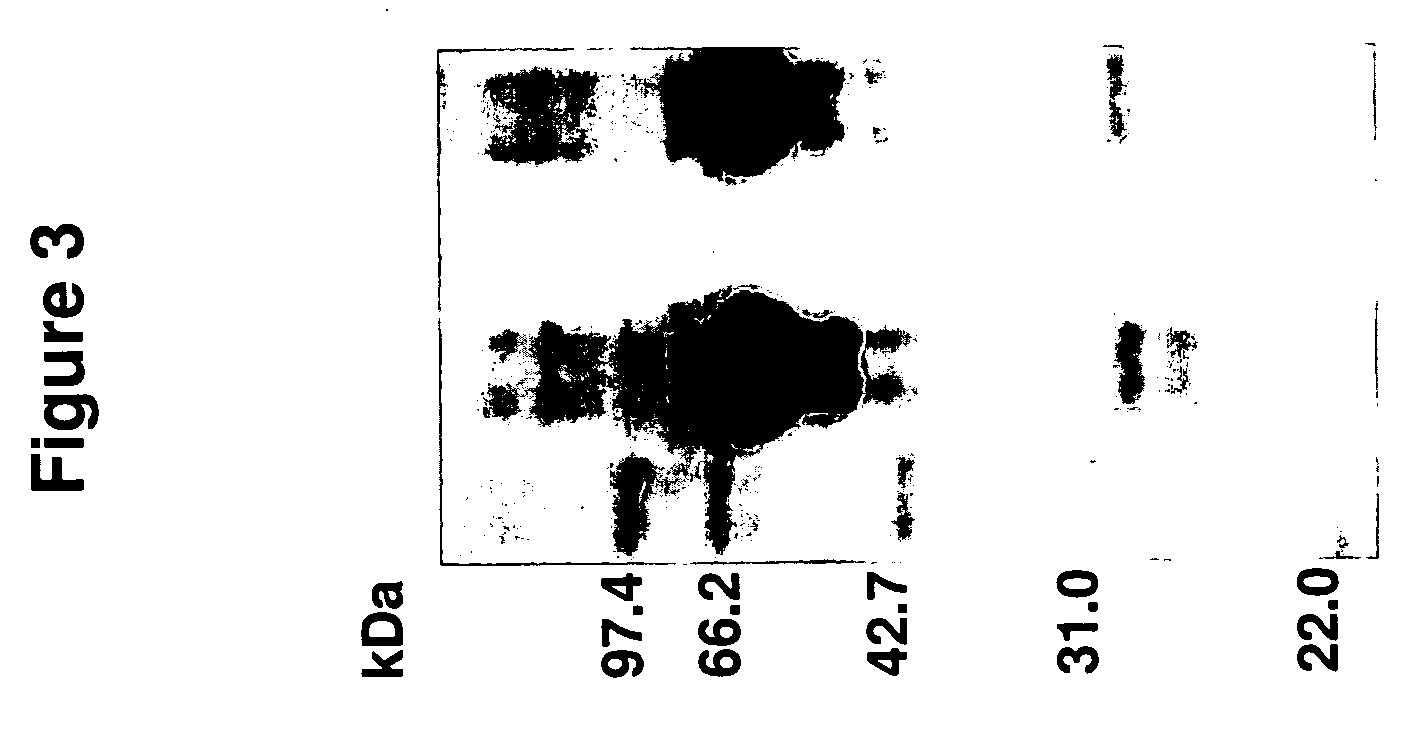Affinity matrix library and its use
a technology of affinity matrix and library, applied in the field of affinity matrix library and its use, can solve the problems of difficult detection of proteins, inaccessibility of high-throughput approaches to the majority of low-abundance proteins,
- Summary
- Abstract
- Description
- Claims
- Application Information
AI Technical Summary
Benefits of technology
Problems solved by technology
Method used
Image
Examples
example 1
Synthesis of a Typical Affinity Matrix (Epichlorohydrin as the Scaffold)
[0087]Sepharose 4B (100 g) was thoroughly washed with water at a 10:1 ratio, drained, and suspended in 50 ml activating solution (1 M NaOH, 2.5 g sodium borohydride, and 10 ml epichlorohydrin). The mixture was tumbled for 2 h at 60° C. The activated gel was then washed thoroughly with 10:1 distilled water until the Ph of the eluate was 7.0. After draining, 20.0 g activated Sepharose 4B was placed into a glass bottle with a stopper. 0.5 g amino compounds (e.g., 2-aminobenzimidazole) (Table 1) was dissolved with 25 ml 1,4-dioxane contained 0.1M NaOH, then transferred into the same bottle. The mixture tumbled for 24 h at 60° C. Mercaptoethanol (1.0 ml) was then added into the bottle and continued to tumble for 2 h at 60° C. Finally, the gel was washed thoroughly with 10:1 distilled water until the Ph of eluate solution was 7.0 and suspended in 20% (v / v) ethanol for storage (FIG. 1). The density of the epoxy groups ...
example 2
Synthesis of Another Typical Affinity Matrix (Cyanuric Chloride as the Scaffold)
[0088]After 100 g Sepharose 4B was activated by epichlorohydrin according to the procedure mentioned above, the activated Sepharose 4B was suspended in 350 ml distilled water, and 150 ml 35% ammonia was added. The gel was incubated for 12 h at 30° C. on a rotary shaker (200 rpm), after which it was thoroughly washed with distilled water on a sinter funnel. Aminated Sepharose 4B was suspended in 350 ml 50% (v / v) acetone solution, maintained at 0° C. in an ice-salt bath and 8 g cyanuric chloride (44 mmol) dissolved in 70 ml acetone was added over a period of 2 h with shaking; Ph was maintained at neutral by the addition of 1 M NaOH. A ninhydrin test was performed to indicate the existence of free amino groups on aminated Sepharose 4B and the linkage of cyanuric chloride in the following procedure: a small aliquot of gel was smeared on filter paper, sprayed with ninhydrin solution [0.2% (w / v) in acetone], a...
example 3
Use of the Synthetic Affinity Matrix Library to Treat Leech Protein (Screening of Solid Phase Supported Ligands for Protein Binding)
[0091]Of the seven hundred columns of synthetic ligands that were constructed, two hundred and ninety-seven columns were selected to bind leech protein. The two hundred ninety-seven affinity matrix Gels (1 ml) were packed into small polystyrene columns with porous discs at both the bottom and the top of the gel to bind leech extract proteins. The columns were equilibrated with a 10-fold column volume of 10 mm phosphate buffer (Ph 7.0). The crude extract of leech was loaded onto the columns. Phosphate buffer (10 mm) was applied to elute out the flow-through fraction until the baseline of UV monitor went down to the bottom. The flow-through eluate was collected. After that, 0.1 M acetic acid was applied to elute out the fraction of bound protein. Finally, 0.1 M NaOH plus 30% ethanol was applied to wash and clean the column until the baseline of UV monitor...
PUM
| Property | Measurement | Unit |
|---|---|---|
| Adhesion strength | aaaaa | aaaaa |
| Therapeutic | aaaaa | aaaaa |
| Affinity | aaaaa | aaaaa |
Abstract
Description
Claims
Application Information
 Login to View More
Login to View More - R&D
- Intellectual Property
- Life Sciences
- Materials
- Tech Scout
- Unparalleled Data Quality
- Higher Quality Content
- 60% Fewer Hallucinations
Browse by: Latest US Patents, China's latest patents, Technical Efficacy Thesaurus, Application Domain, Technology Topic, Popular Technical Reports.
© 2025 PatSnap. All rights reserved.Legal|Privacy policy|Modern Slavery Act Transparency Statement|Sitemap|About US| Contact US: help@patsnap.com



